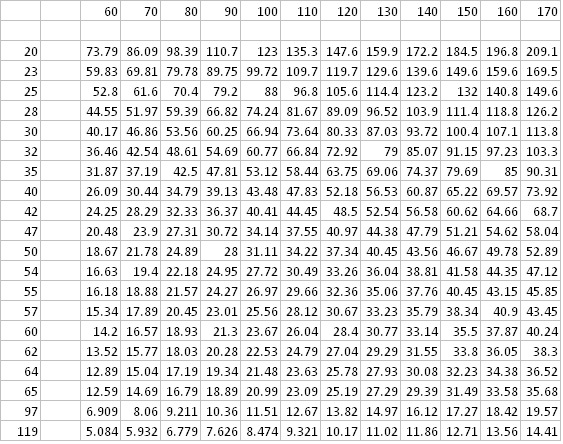Proper bicycle tire pressure is a topic of endless fascination... and endless debate! On the one hand, what exactly is the goal? It is probably some combination of efficiency, comfort, handling, durability, etc. But the optimum pressure for reaching that goal will depend on many factors: the tire itself - its shape and construction - the load one is carrying, the surfaces on which one is riding, etc.
Frank Berto did some analysis, appearing here and here. Surley makes bikes with very fat tires and has some nice discussion about tire pressure here. There is also a thread on the Thorn forum, where I worked out a hypothesis that, using Berto's "uniform drop" theory, should vary proportionally with the load and inverse proportionally with the 3/2 power of the tire width.
I came up with a constant of proportion to give a reasonable fit with the published graphs by Berto. The fit is not very exact though... whether my formula gives better pressures than Berto's graphs can be left as an exercise for the reader/rider. In any case my formula is easily evaluated for a wider range of loads and tire widths than Berto's graphs cover.
Here, then, is a table of suggested tire pressures. Across the top, find the load, in pounds, on the single wheel, e.g. roughly half the total load on the two wheels of a bicycle. Along the left side, find the width of the tire in mm. The number at the corresponding column and row of the table is then the suggested pressure in psi. Click on the table to get the full image which includes higher loads.


Note: of course the pressure suggested here might be more than the tire can withstand, or more than the tire and rim together. A wide tire on a narrow rim will not tolerate high pressure. If the pressure suggested here is too high, then really that load will require a different tire or rim or both.
ReplyDeleteWow, here is someone with a formula that includes width raised to a power very close to -3/2. Great to see:
ReplyDeletehttp://www.biketinker.com/2010/bike-resources/optimal-tire-pressure-for-bicycles/
This fit to Berto is based on 700C wheels. Pressure should be increased inversely proportional to the square root of the wheel diameter. So 26 inch pressures should be about 5% higher than what's here.
ReplyDeleteSee also the research by Jan Heine, e.g. https://janheine.wordpress.com/2015/02/17/tire-pressure-data-and-details/
ReplyDeleteThis comment has been removed by a blog administrator.
ReplyDelete
ReplyDeleteI switched my commuter hybrid from 32mm puncture magnets to the 23mm version of the Maxxis Refuse. They have never punctured. I now also have these (25mm) on my flat bar-converted road bike. Never had a puncture. car tire pressure gauge
I have Schwalbe Big Ben 26 x 2.1 tires and I weigh about 180 pounds and my ebike wieghs about 60 pounds. According to the table, I should be running them at 35-40 pounds, but recently I had the rear tire at about 45 pounds and had a sidewall blowout. Is that a sign of too little pressure or too much?
ReplyDeleteIt doesn't sound like a pressure problem at all. 45 psi ought to be perfectly fine. Seems like some kind of sidewall damage is the usual cause, maybe hitting something on the road. If they were newly mounted, could have be an installation problem. If they've been on a long long time, maybe they just wore out. Certainly too low pressure will cause the sidewalls to flex a lot and eventually wear out, but that should take years.
Deletea nice thread: http://www.bikeforums.net/hybrid-bicycles/672569-proper-tire-pressure-somehow-related-rider-weight.html
ReplyDeleteincludes a link to: https://silca.cc/blogs/journal/part-4b-rolling-resistance-and-impedance
I found this is an informative and interesting post so i think so it is very useful and knowledgeable. I would like to thank you for the efforts you have made in writing this article.
ReplyDeleteCycling
Jan Heine with more insight - keep your front tire inflated enough for the greater weight it carries when braking! https://janheine.wordpress.com/2018/06/11/myth-11-rear-tires-should-run-at-higher-pressure/
ReplyDeleteSome things in here I have not thought about before.Thanks for making such a cool post which is really very well written.
ReplyDeletetire shop
flat tires near me
tire pressure
Here's an authoritative-looking tire pressure chart. Interesting that the pressure is not proportional to rider weight. Hmmm, it should be proportional to total load, i.e. include the weight of the bike, water bottles, clothing, etc. Seems like add about 50 pounds for all that and maybe their formulas become proportional to load... anyway: http://www.gravelcyclist.com/bicycle-tech/gravel-bike-tyre-tire-pressure-guidelines-by-enve-composites/
ReplyDelete